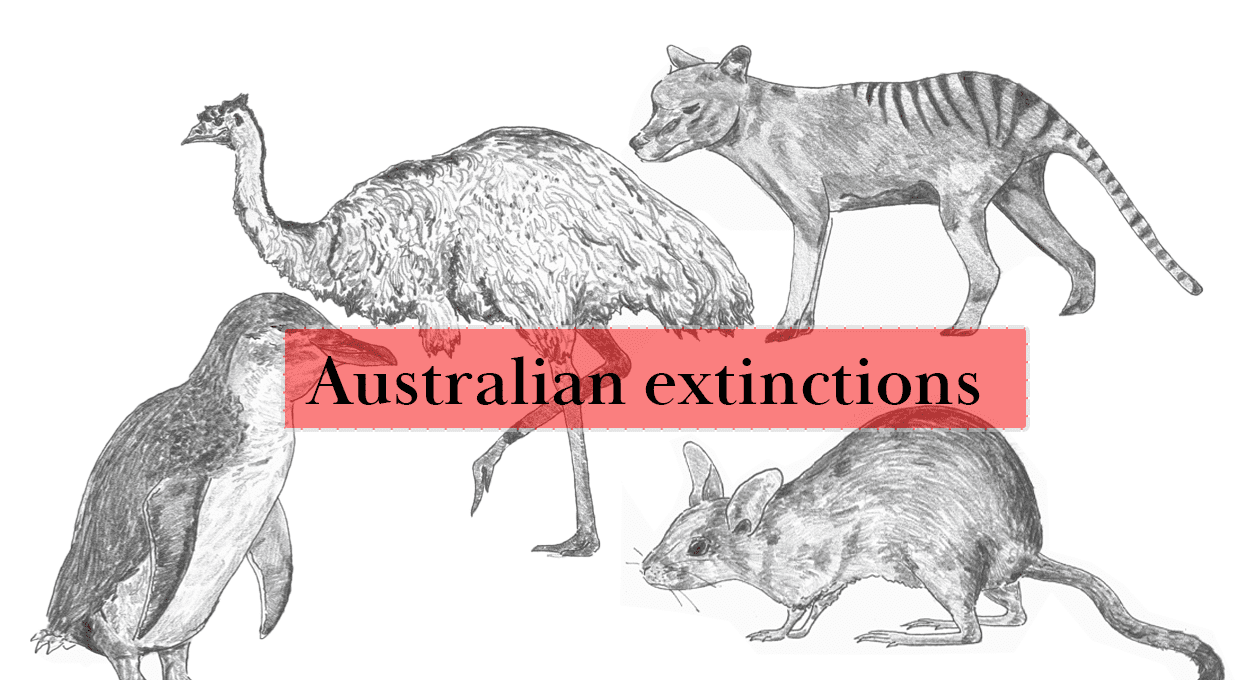The earth is fat with yams, and the sky is bright with stars.
Fleets of soft-nosed native mice vanish into the sand and little penguins climb up the shore in pairs to return home for the nesting season. Choruses of bell frogs buried deep into the flesh of wetlands add cheery trombone notes to a network of puddled harmonies. Sunk low among the damp grassland, a mid-mythic assembly of shadows striking rust-brown fur.
**
Australia may have some of the worst climate policy in the world, but we lead in permanent erasure of entire species with 43 extinctions and 152 critically endangered species. Much of these, if not all of them, can be attributed to European colonisation.
Most of our native rodents were wiped out. And you can use the good old excuses of oh, but Australian wildlife was very prehistoric blah blah, and was never going to survive regardless blah blah — but no. Rodent species’ genomic data actually strongly implicates post-1788 anthropogenic impacts in Australia as the driving force in their extinction. The tested species had sufficient variance in their genetic material to suggest a stability in their population. Essentially, there was no gradual decline resulting from a poorly functioning gene pool — rather, there was a sharp decrease in numbers related to the government’s active endorsement of their slaughter.
For hopping mice alone, 2.5 million bounties were recorded between 1883 and 1920 in NSW – that’s settlers being paid to hand in mouse corpses. Meanwhile in Tasmania, thylacines were used as scapegoats for wool failure and people were awarded more than 2100 bounties by the government from 1830-1909, resulting in the marsupials being hunted to extinction by the 1930s (or the 60s, or the 80s, depending on which cryptozoologist you ask).
And yet, jokes about these efforts are rife in our cultural consciousness — we ridicule the “bin chickens” that we view as vermin, just as the thylacine was demonised in natural history.
Source: Waterhouse, G. R. (1841). Marsupialia or Pouched Animals Vol XI of Mammalia. Edinburgh.
Source: Burrell, H. (1928). Postcard of ‘Tasmanian Marsupial Wolf’ – the Thylacine [Photograph]. Australian Museum, Sydney.
We laugh about the Emu War that we lost -– twice! –- and it is just a story. I wonder what the emus think of that story. Twenty-thousand emus who returned home after their breeding season only to find their habitat cancerous with monocultural wheat fields and shot at with literal machine guns. Settlers complained of “ruined” crops, when they couldn’t possibly understand what it meant for something to really be ruined. Thousands of emus were killed by armed settlers cornering them against fences, and photographs show gleeful participants hoisting the corpses on their shoulders. Our systems continue to disrespect our native faunas’ habitats, reflected in the 67% decrease of mature pink cockatoos within a generation. The reasons for these birds’ decline are cited as habitat loss from land clearing, as well as food decrease due to competition with feral goats. The recent bushfires have also destroyed key nesting sites. We make promises to restore habitat, “offset”, everything can be built back better than it was before –- but these hollows take centuries to form, and no artificial nesting box can replace them.
Another key threat to native species that is perpetuated by colonisation is the introduction of invasive species. Sheep were brought to Australia, which destroy water sources, yam crops and grasses that other native species depend upon. European colonisers also introduced foxes for sport in the 1840s, and 15 of Australian extinctions are now linked to them. They’re also considered an ongoing threat to 78 native species in Australia, including the endangered little penguins in Manly, who are snatched from their burrows every year.
**
We have said goodbye to so many endlings — the last survivors of a subsequently extinct species. We are in the midst of the sixth mass extinction event and with Australia’s track record, and it would be ignorant to assume that we will escape it unscathed.
Colonisation has done irreparable damage to Australian wildlife through its endorsement of animal eradication, introduction of invasive species, and harmful land practices. This damage continues to have impacts on the present, not only because ecosystems struggle to recover, but because Australian power systems have ongoing failures when it comes to environmental management. The same way that native rodents and thylacines were excised from their homes by settlements that directly attacked them, little penguins and other species are being gradually chased out of their homes by a system that doesn’t prioritise them.





